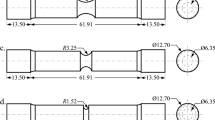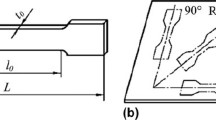Abstract
Slant fracture is widely observed during crack growth in thin sheet specimens made of ductile materials, providing a good case for investigating three-dimensional criteria for mixed-mode ductile fracture. To gain an understanding of slant fracture events and to provide insight for establishing a slant fracture criterion, stable tearing fracture experiments on combined tension-torsion (nominal mixed-mode I/III) specimens and nominal Mode I Arcan specimens made of Al 2024-T3 are analyzed using the finite element method under three-dimensional conditions. Two types of finite element models are considered for the study of slant fracture: (a) combined tension-torsion specimens containing stationary, flat and slant cracks subject to loads corresponding to the onset of crack growth, and (b) stable tearing crack growth with slanting in a nominal Mode I Arcan specimen. Analysis results reveal that there exists a strong correlation between certain features of the crack-front effective plastic strain field and the orientation of the slant fracture surface. In particular, it is observed that (a) at the onset of crack growth in the combined tension-torsion experiments, the angular position of the maximum effective plastic strain around the crack front serves as a good indicator for the slant fracture surface orientation during subsequent crack growth; and (b) during stable tearing crack growth in the Mode I Arcan specimen, which experiences a flat-to-slant fracture surface transition, the crack growth path on each section plane through the thickness of the specimen coincides with the angular position of the maximum effective plastic strain around the crack front.
Similar content being viewed by others
References
Amstutz BE (1995) Characterization of mixed-mode stable tearing in thin sheet 2024-T3 aluminum alloy. Master thesis, University of South Carolina, Columbia, SC 29208
ANSYS Finite Element Code, ANSYS, Inc. Canonsburg, PA
Bao Y, Wierzbicki T (2004) A comparative study on various ductile crack formation criteria. J Eng Mater Technol 126:314–324
Besson J, Brocks W, Chabanet O, Steglich D (2001) Ductile rupture of aluminum sheet materials. Eur J Finite Element 10:401–415
Bron F, Besson J, Pineau A (2004) Ductile rupture in thin sheets of two grades of 2024 aluminum alloy. Mater Sci Eng A 380:356–364
Dawicke DS, Sutton MA (1994) CTOA and crack tunneling measurements in thin sheet 2024-T3 aluminum alloy. Exp Mech 34:357–368
Deng X, Newman JC (1999) A study of some issues in stable crack growth simulations. Eng Frac Mech 64:291–304
Gao X, Shih CF (1998) A parametric study of mixed-mode I/III ductile fracture in tough materials under small scale yielding. Eng Frac Mech 60:407–420
Gullerud A, Dodds R, Hampton R, Dawicke D (1999) Three dimensional modeling of ductile crack growth in thin sheet metals: computational aspects and validation. Eng Frac Mech 63:347–373
Hancock JW, Mackenzie AC (1976) On the mechanisms of ductile failure in high-strength steels subjected to multi-axial stress-states. J Mech Phys Solids 24:147–169
Hui CY, Zehnder AT (1993) A theory for the fracture of thin plates subjected to bending and twisting moments. Int J Frac 61:211–229
James MA, Newman JC (2003) The effect of crack tunneling on crack growth: experiments and CTOA analyses. Eng Frac Mech 70:457–468
Krafft JM, Sullivan AM, Boyle RW (1961) Effect of dimensions on fast fracture instability of notched sheets. In: Proceedings of the crack propagation symposium, vol 1. Cranfield, UK, 1961
Kumar AM, Hirth JP (1991) Mixed-Mode I/III fracture testing. Scripta Metall Mater 25:985–990
Lan W, Deng X, Sutton MA, Zuo J, Cheng CS (2004) Three-dimensional finite element analyses of stable ductile fracture tests. In: Proceeding of international conference on fracture and damage of advanced materials. Hangzhou, China, pp 216–226
Ma F, Deng X, Sutton MA, Newman JC (1999) A CTOD-based mixed-mode fracture criterion. In: Miller KJ, McDowell DL (eds) Mixed-mode crack behavior, ASTM STP 1359. American Society for Testing and Materials, West Conshohocken, PA, pp 86–110
Mahgoub E, Deng X, Sutton MA (2003) Three-dimensional stress and deformation fields around flat and slant cracks under remote Mode I loading conditions. Eng Frac Mech 70:2527–2542
Mahmoud S, Lease K (2003) The effect of specimen thickness on the experimental characterization of critical crack-tip-opening angle in 2024-T351 aluminum alloy. Eng Frac Mech 70:443–456
Manoharan M (1997) Development of a mixed-mode fracture mechanism map and its extension to mixed-mode fracture. In: Recent advances in fracture, proceedings of a symposium held at the annual meeting of the minerals. Metals and Materials Society, pp 373–384
McClintock FA (1968) A criterion of ductile fracture by the growth of holes. J Appl Mech 35:363–371
Meyn DA, Webb TW, Aifantis EC (1989) Hydrogen-assisted cracking studies of 4340 steel by using the optical method of caustics. Eng Frac Mech 33:913–925
Narasimhan R, Rosakis AJ, Moran B (1992) A three-dimensional numerical investigation of fracture initiation by ductile failure mechanisms in a 4340 steel. Int J Frac 56:1–24
Pan J (1990) Asymptotic analysis of a crack in a power-law material under combined in-plane and out-of-plane shear loading conditions. J Mech Phys Solids 38:133–159
Pan J, Shih CF (1990) Elastic-plastic analysis of combined mode I and mode III crack-tip fields under small-scale yielding conditions. J Mech Phys Solids 38:161–181
Randolph LW, Piascik RS (1995) Three-dimensional crack growth assessment by microtopographic examination. ASTM STP 1256 on Fracture Mechanics, pp. 303–318
Rice JR, Tracey DM (1969) On the ductile enlargement of voids in triaxial stress fields. J Mech Phys Solids 17:201–217
Rickerby DG, Fenici P (1984) Fatigue crack growth in thin section type 316 stainless steel. Eng Frac Mech 19:585–599
Rousselier G (1987) Ductile fracture models and their potential in local approach of fracture. Nuclear Eng Design 105:97–111
Steglich D, Brocks W (1998) Micromechanical modeling of damage and fracture of ductile materials. Fatigue Frac Eng Mater Struct 21:1175–1188
Sutton MA, Helm JD, Boone ML (2001) Experimental study of crack growth in thin sheet 2024-T3 aluminum under tension-torsion loading. Int J Frac 109:285–301
Sutton MA, Deng X, Ma F, Newman JC, James M (2000) Development and application of a crack tip opening displacement-based mixed mode fracture criterion. Int J Solids Struct 37:3591–3618
Sutton MA, Zhao W, Boone ML, Reynolds AP, Dawicke DS (1997) Prediction of crack growth direction for mode I/II loading using small-scale yielding and void initiation/growth concepts. Int J Frac 83:275–290
Walsh JA, Jata KV, Starke EA Jr (1989) The influence of Mn dispersoid content and stress state on ductile fracture of 2134 type Al alloys. Acta Metall 37:2861–2871
Zehnder AT, Viz MJ, Potdar Y (2000) Fatigue fracture in plates in tension and out-of-plane shear. Fatigue Frac Eng Mater Struct 23:403–415
Zuidema J, Blaauw HS (1988) Slant fatigue crack growth in Al 2024 sheet material. Eng Frac Mech 29:401–413
Zuo J, Deng X, Sutton MA (2004) Computational aspects of 3D crack growth simulations. In: Paper # IMECE 2004–60699, Proceedings of 2004 ASME international mechanical engineering congress, Nov. 13–20, 2004, Anaheim, CA
Zuo J, Deng X, Sutton MA (2005) Advances in tetrahedral mesh generation for modeling of three-dimensional regions with complex, curvilinear crack shapes. Int J Numer Methods Eng 63:256–275
Author information
Authors and Affiliations
Corresponding author
Rights and permissions
About this article
Cite this article
Lan, W., Deng, X., Sutton, M.A. et al. Study of slant fracture in ductile materials. Int J Fract 141, 469–496 (2006). https://doi.org/10.1007/s10704-006-9008-7
Received:
Accepted:
Published:
Issue Date:
DOI: https://doi.org/10.1007/s10704-006-9008-7




